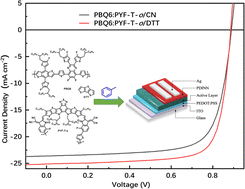Solid additive tuning of polymer blend morphology enables non-halogenated-solvent all-polymer solar cells with an efficiency of over 17%†
Abstract
All-polymer solar cells (all-PSCs) have attracted considerable interest owing to their superior device stability and mechanical robustness. Recently, all-PSCs have achieved high power conversion efficiency (PCE) of over 17% benefitting from the development of polymerized small molecular acceptors. However, most all-PSCs are processed using halogenated solvents that are hazardous to the environment. Herein, non-halogenated solvent toluene is utilized with a large amount of volatilizable DTT (dithieno[3,2-b:2′,3′-d]thiophene) solid additive, for eco-friendly and highly efficient all-PSCs. The DTT solid-additive treatment can fine-tune the aggregation of the polymer donor and polymer acceptors, and the resulting active layer possesses appropriate domain size and high domain purity with bi-continuous-interpenetrating networks. Consequently, the treatment of DTT additive enables the high-performance non-halogenated solvent processed all-PSCs based on PBQ6:PYF-T-o with PCE up to 17.06% (certified PCE of 16.6%), which is among the highest efficiencies in non-halogenated-solvent-processed all-PSCs to date. Importantly, the toluene-processed active layer of all-PSCs can be successfully fabricated under ambient conditions with the help of the DTT additive, and the device fabricated under ambient conditions showed a higher PCE of 15.74%. This study highlights the importance of a solid-additive strategy in controlling the active layer morphology for practical applications of high-performance and environment-friendly all-PSCs.



 Please wait while we load your content...
Please wait while we load your content...